| This article appears to contradict itself on the sizes of craters. Please see the talk page for more information. (January 2018) |
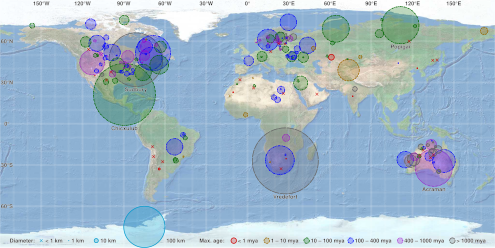
Download coordinates as:
This list of impact structures (including impact craters) on Earth contains the majority of the 194+ confirmed impact structure given in the Earth Impact Database as of 2024.
Alphabetical lists for different continents can be found under Impact structures by continent below.
Confirmed impact structures listed by size and age
These features were caused by the collision of meteors (consisting of large fragments of asteroids) or comets (consisting of ice, dust particles and rocky fragments) with the Earth. For eroded or buried craters, the stated diameter typically refers to the best available estimate of the original rim diameter, and may not correspond to present surface features. Time units are either in ka (thousands) or Ma (millions) of years.
10 ka or less
Less than ten thousand years old, and with a diameter of 100 m (330 ft) or more. The EID lists fewer than ten such craters, and the largest in the last 100,000 years (100 ka) is the 4.5 km (2.8 mi) Rio Cuarto crater in Argentina. However, there is some uncertainty regarding its origins and age, with some sources giving it as < 10 ka while the EID gives a broader < 100 ka.
The Kaali impacts (c. 1500 BC) during the Nordic Bronze Age may have influenced Estonian and Finnish mythology, the Campo del Cielo (c. 2500 BC) could be in the legends of some Native Argentine tribes, while Henbury (c. 2700 BC) has figured in Australian Aboriginal oral traditions.

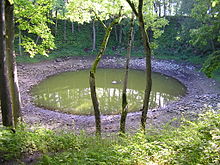
For the Rio Cuarto craters, 2002 research suggests they may actually be aeolian structures. The EID gives a size of about 50 m (160 ft) for Campo del Cielo, but other sources quote 100 m (330 ft).
10 ka to 1 Ma
From between 10 thousand years and one million years ago, and with a diameter of less than one km (0.62 mi):
| Name | Location | Country | Diameter (km) |
Age (ka) |
Coordinates |
|---|---|---|---|---|---|
| Wolfe Creek | Western Australia | Australia | 0.9 | < 120 | 19°10′18″S 127°47′44″E / 19.17167°S 127.79556°E / -19.17167; 127.79556 |
| Hickman | 0.26 | 10-100 | |||
| Kalkkop | Eastern Cape | South Africa | 0.64 | ~250 | |
| Jeokjung-Chogye Basin | Gyeongsangnam | South Korea | 8 | 30-63 | |
| Monturaqui | Atacama Desert | Chile | 0.455 | 640 ± 140 | 23°55′40″S 68°15′41″W / 23.92778°S 68.26139°W / -23.92778; -68.26139 |
| Pantasma | Jinotega | Nicaragua | 14 | 804 |
From between ten thousand years and one million years ago, and with a diameter of one km (0.62 mi) or more. The largest in the last one million years is the 14-kilometre (8.7 mi) Zhamanshin crater in Kazakhstan and has been described as being capable of producing a nuclear-like winter.
The source of the enormous Australasian strewnfield (c. 780 ka) is a currently undiscovered crater probably located in Southeast Asia.

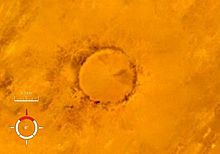
| Name | Location | Country | Diameter (km) |
Age (ka) |
Coordinates |
|---|---|---|---|---|---|
| Yilan | Heilongjiang | China | 01.85 | 049 | 46°23′4″N 129°19′39″E / 46.38444°N 129.32750°E / 46.38444; 129.32750 |
| Meteor Crater | Arizona | United States | 01.2 | 049 | 35°1′39″N 111°1′22″W / 35.02750°N 111.02278°W / 35.02750; -111.02278 |
| Xiuyan | Xiuyan | China | 01.8 | 050 | 40°21′42″N 123°27′47″E / 40.36167°N 123.46306°E / 40.36167; 123.46306 |
| Lonar | Maharashtra | India | 01.8 | 052 | 19°58′37″N 76°30′32″E / 19.97694°N 76.50889°E / 19.97694; 76.50889 |
| Agoudal | Atlas Mountains | Morocco | 03.0 | 105 | 31°59′N 5°30′W / 31.983°N 5.500°W / 31.983; -5.500 |
| Tswaing | Pretoria Saltpan | South Africa | 01.1 | 220 | 25°24′32″S 28°4′58″E / 25.40889°S 28.08278°E / -25.40889; 28.08278 |
| Zhamanshin | Kazakhstan | Kazakhstan | 14.0 | 900 ± 100 | 48°24′0″N 60°58′0″E / 48.40000°N 60.96667°E / 48.40000; 60.96667 |
1 Ma to 10 Ma
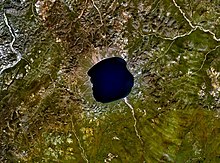

From between 1 and 10 million years ago. The large but apparently craterless Eltanin impact (2.5 Ma) into the Pacific Ocean has been suggested as contributing to the glaciations and cooling during the Pliocene.
10 Ma or more
Most recorded impact craters are over 10 million years old, or have widely uncertain ages. The Chicxulub impact has been widely considered the most likely cause for the Cretaceous–Paleogene mass extinction, with some scholars linking other impacts like the Popigai impact in Russia and the Chesapeake Bay impact to later extinction events, though the causal relationship has been questioned.




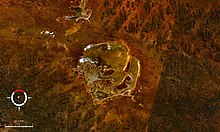


Inferred impact events
Some impact events are only known from events like layers of spherules or tektites generated by the impact recorded in contemporary rocks, and their impact structures may no longer exist.
| Name | Location | Country | Diameter (km) | Age (million years) | Coordinates |
|---|---|---|---|---|---|
| Eltanin impact | Southern Ocean | Bellingshausen Sea southwest of Chile (layer of unmelted and melted meteoritic debris found in deep sea cores) | none | 2.5 | 57°47′S 90°47′W / 57.783°S 90.783°W / -57.783; -90.783 |
| Australasian strewnfield | Unknown (likely Southeast Asia) | Unknown | Unknown, possibly ~15 | 0.788 | N/A |
| Nuussuaq (Disko) spherule bed | Unknown | Unknown (spherule bed found in Nuussuaq Peninsula, Western Greenland) | Unknown | ~61-62 | |
| Qidong spherule bed | Unknown | Unknown (spherule bed found near Qidong, Hunan, China) | Unknown | ~374 | |
| Senzeilles (Hony) microtektite bed | Unknown | Unknown (microtektite bed found in Belgium) | Unknown | ~376 | |
| Osmussaar breccia | eastern Gulf of Finland region | Unknown (breccia layer found in Estonia) | Unknown | ~466 | |
| Vakkejokk Breccia | Northern Scandinavia | Likely northern Sweden (proximal ejecta layer found in the North-Swedish Caledonides) | Around 4-5 | ~520 | |
| Kitkiöjärvi impact melt | Northern Scandinavia | Likely either northern Sweden or northern Finland (impact melt rock found in glacial deposits in gravel pit) | Unknown | 658.9 ± 6.9 | |
| Unnamed | Northern Greenland | Denmark (impact melt rock found in glaciofluvial deposits in Inglefield Land, Greenland) | Unknown | 1039 ± 16 | |
| Stac Fada Member | Scotland | Scotland (proximal ejecta layer found in Scotland) | Likely around 13-14 | 1177 ± 5 | |
| Paraburdoo-Reivilo spherule bed | Unknown | Unknown (spherule beds found in South Africa and Australia) | Unknown | ~2570 | |
| Monteville-Carawine-Jeerinah spherule bed | ~2630 | ||||
| S1-Warrawoona spherule bed | Likely in the range of 400-1000 | ~3472 | |||
| S2 spherule bed | Unknown (spherule beds found in South Africa) | Estimated to be around 500 | ~3260 | ||
| S3 spherule bed | Likely in the range of 400-1000 | ~3243 | |||
| S4 spherule bed | ~3240 | ||||
| S5 spherule bed | ~3225 | ||||
| S6 spherule bed | ~3256 | ||||
| S7 spherule bed | ~3416 | ||||
| S8 spherule bed | ~3298 |
Sublists and statistics of impact structures by continent
As of 2022, the Earth Impact Database (EID) contains 190 confirmed impact structures. The table below is arranged by the continent's percentage of the Earth's land area, and where Asian and Russian structures are grouped together per EID convention. The global distribution of known impact structures apparently shows a surprising asymmetry, with the small but well-funded European continent having a large percentage of confirmed impact structures. It is suggested this situation is an artifact, highlighting the importance of intensifying research in less studied areas like Antarctica, South America and elsewhere.
Links in the column "Continent" will give a list of craters for that continent.
| Continent | Continent's % of Earth's land area |
Continent's % of the 190 known impact structures |
Number of impact structures |
|---|---|---|---|
| Asia and Russia | 30% | 16% | 31 |
| Africa | 20% | 11% | 20 |
| North America | 16% | 32% | 60 |
| South America | 12% | 6% | 11 |
| Antarctica | 9% | 0% | 1 |
| Europe | 7% | 22% | 41 |
| Australia | 6% | 14% | 27 |
| Total | 100% | 100% | 190 |
See also
- Bolide – Extremely bright meteor
- Earth Impact Database – Database of impact structures on Earth
- Extinction event – Widespread and rapid decrease in the biodiversity on Earth
- Impact event – Collision of two astronomical objects
- Impact Field Studies Group
- List of craters in the Solar System
- List of largest craters in the Solar System
- List of possible impact structures on Earth
- Traces of Catastrophe – Comprehensive technical reference on the science of impact craters
- Giant-impact hypothesis – Hypothesis of the formation of the Moon
- Deniliquin multiple-ring feature – Buried feature in southeast Australia, suggested to be an impact structure (520 km-diameter crater would be the largest one on Earth)
References
- ^ "Earth Impact Database". University of New Brunswick. Retrieved 2016-04-30.
- ^ Bland, Phil A.; de Souza Filho, C. R.; Timothy Jull, A. J.; Kelley, Simon P.; Hough, Robert Michael; Artemieva, N. A.; Pierazzo, E.; Coniglio, J.; Pinotti, Lucio; Evers, V.; Kearsley, Anton; (2002); "A possible tektite strewn field in the Argentinian Pampa", Science, volume 296, issue 5570, pp. 1109–12
- ^ "Rio Cuarto". Earth Impact Database. Planetary and Space Science Centre University of New Brunswick Fredericton. Retrieved 2009-08-19.
- ^ Schultz, Peter H.; Lianza, Ruben E. (1992) "Recent grazing impacts on the Earth recorded in the Rio Cuarto crater field, Argentina", Nature 355, pp. 234–37 (16 January 1992)
- Haas, Ain; Peekna, Andres; Walker, Robert E. "Echoes of Ancient Cataclysms in the Baltic Sea" (PDF). Electronic Journal of Folklore. Retrieved 2008-10-26.
- Benítez, Giménez; López, Alejandro M.; Mammana, Luis A. "Meteorites of Campo del Cielo: Impact on the indian culture".
- ^ Bobrowsky, Peter T.; Rickman, Hans (2007). Comet/asteroid impacts and human society: an interdisciplinary approach. Springer. pp. 30–31. ISBN 978-3-540-32709-7.
- Hamacher, Duane W.; Goldsmith, John. "Aboriginal oral traditions of Australian impact craters" (PDF). Archived from the original (PDF) on 2018-08-20. Retrieved 2016-04-09.
- Stankowski, Wojciech; Raukas, Anto; Bluszcz, Andrzej; Fedorowicz, Stanisław. "Luminescence dating of the Morasko (Poland), Kaali, Ilumetsa, and Tsõõrikmäe (Estonia) meteorite craters" (PDF).
- Cione, Alberto L.; et al. (2002). "Putative Meteoritic Craters in Río Cuarto (Central Argentina) Interpreted as Eolian Structures". Earth, Moon, and Planets. 91 (1): 9–24. Bibcode:2002EM&P...91....9C. doi:10.1023/A:1021209417252. S2CID 122467947.
- Essay "Impact Cratering on Earth", based on: Grieve, Richard A. F. (1990). "Impact cratering on the Earth". Scientific American. 262 (4): 66–73. Bibcode:1990SciAm.262d..66G. doi:10.1038/scientificamerican0490-66.
- Povenmire, Harold; Liu, W.; Xianlin, Luo (1999) "Australasian tektites found in Guangxi Province, China", in Proceedings of the 30th Annual Lunar and Planetary Science Conference, Houston, March 1999
- Glass, Billy P.; Pizzuto, James E. (1994) "Geographic variation in Australasian microtektite concentrations: Implications concerning the location and size of the source crater", Journal of Geophysical Research, vol. 99, no. E9, 19075–81, September 1994
- "Agoudal". Earth Impact Database. Planetary and Space Science Centre University of New Brunswick Fredericton. Retrieved 2016-08-18.
- University of New South Wales (19 September 2012). "Did a Pacific Ocean meteor trigger the Ice Age?". Retrieved 8 October 2012.
- Rampino, Michael R. (February 2020). "Relationship between impact-crater size and severity of related extinction episodes". Earth-Science Reviews. 201: 102990. Bibcode:2020ESRv..20102990R. doi:10.1016/j.earscirev.2019.102990.
- Cohen, Benjamin E.; Mark, Darren F.; Lee, Martin R.; Simpson, Sarah L. (2017-08-01). "A new high-precision Ar/Ar age for the Rochechouart impact structure: At least 5 Ma older than the Triassic–Jurassic boundary". Meteoritics & Planetary Science. 52 (8): 1600–11. Bibcode:2017M&PS...52.1600C. doi:10.1111/maps.12880. hdl:10023/10787. ISSN 1945-5100.
- McGregor, Maree; Dence, Michael R.; McFarlane, Christopher R. M.; Spray, John G. (July 2020). "U–Pb geochronology of apatite and zircon from the Brent impact structure, Canada: a Late Ordovician Sandbian–Katian boundary event associated with L-Chondrite parent body disruption". Contributions to Mineralogy and Petrology. 175 (7): 63. Bibcode:2020CoMP..175...63M. doi:10.1007/s00410-020-01699-9. ISSN 0010-7999.
- Goff, James; Catherine Chagué-Goff; Michael Archer; Dale Dominey-Howes; Chris Turney (3 September 2012). "The Eltanin asteroid impact: possible South Pacific palaeomegatsunami footprint and potential implications for the Pliocene-Pleistocene transition". Journal of Quaternary Science. 27 (7). Wiley: 660. Bibcode:2012JQS....27..660G. doi:10.1002/jqs.2571. ISSN 0267-8179. S2CID 131415717.
- Sieh, Kerry; Herrin, Jason; Jicha, Brian; Schonwalder Angel, Dayana; Moore, James D. P.; Banerjee, Paramesh; Wiwegwin, Weerachat; Sihavong, Vanpheng; Singer, Brad; Chualaowanich, Tawachai; Charusiri, Punya (2020-01-21). "Australasian impact crater buried under the Bolaven volcanic field, Southern Laos". Proceedings of the National Academy of Sciences. 117 (3): 1346–1353. Bibcode:2020PNAS..117.1346S. doi:10.1073/pnas.1904368116. ISSN 0027-8424. PMC 6983392. PMID 31889003.
- Jourdan, F.; Nomade, S.; Wingate, M.T.; Eroglu, E.; Deino, A. (2019). "Ultraprecise age and formation temperature of the Australasian tektites constrained by 40Ar/39Ar analyses". Geological Society of America Bulletin. 54 (10): 2573–2591. doi:10.1111/maps.13305. ISSN 1086-9379.
- Jones, A.P.; Kearsley, A.T.; Friend, C.R.L.; Robin, E.; Beard, A.; Tamura, A.; Trickett, S.; Claeys, P. (2005). "Are there signs of a large Palaeocene impact, preserved around Disko bay, Greenland- Nuussuaq spherule beds origin by impact instead of volcanic eruption?". Large Meteorite Impacts III. Boulder, Colorado: Geological Society of America. p. 281-298. ISBN 978-0-81372-384-6.
- ^ Glass, B.P.; Simonson, B.M., eds. (2013). Distal Impact Ejecta Layers: A Record of Large Impacts in Sedimentary Deposits (1st ed.). Berlin Heidelberg, Germany: Springer-Verlag. p. 716. ISBN 978-3-540-88261-9.
- Claey, P.; Kyte, A.; Herbosch, A.; Casier, J.G. (1996). "Geochemistry of the Frasnian-Famennian boundary in Belgium: Mass extinction, anoxic oceans and microtektite layer, but not much iridium". The Cretaceous-Tertiary Event and Other Catastrophes in Earth History. Boulder, Colorado: Geological Society of America. p. 491-504. ISBN 978-0-81372-307-5.
- Alwmark, C.; Schmitz, B.; Kirsimäe, K. (2010). "The mid-Ordovician Osmussaar breccia in Estonia linked to the disruption of the L-chondrite parent body in the asteroid belt". Geological Society of America Bulletin. 122 (7–8): 1039–1046. Bibcode:2010GSAB..122.1039A. doi:10.1130/B30040.1. ISSN 0016-7606.
- Alwmark, Carl; Ormö, Jens; Nielsen, Arne T. (March 2019). "Shocked quartz grains in the early Cambrian Vakkejokk Breccia, Sweden—Evidence of a marine impact". Meteoritics & Planetary Science. 54 (3): 609–620. Bibcode:2019M&PS...54..609A. doi:10.1111/maps.13230. ISSN 1086-9379.
- Alwmark, C.; Kenny, G.G.; Alwmark, S.; Minde, P.; Plado, P.; Hietala, S.; Whitehouse, M.J. (2024). "Cryogenian impact structure lurking in the shadows of northern Sweden". Meteoritics & Planetary Science. 59 (12): 3305–3321. Bibcode:2024M&PS...59.3305A. doi:10.1111/maps.14280. ISSN 1086-9379.
- Hyde, William R.; Kenny, Gavin G.; Jaret, Steven J.; MacGregor, Joseph A.; Beck, Pierre; Whitehouse, Martin J.; Larsen, Nicolaj K. (2024-07-01). "Evidence for ca. 1 Ga hypervelocity impact event found in northwest Greenland". Geology. 52 (7): 517–521. Bibcode:2024Geo....52..517H. doi:10.1130/G51876.1. ISSN 0091-7613.
- Parnell, J.; Mark, D.; Fallick, A.E.; Boyce, A.; Thackrey, S. (2011). "The age of the Mesoproterozoic Stoer Group sedimentary and impact deposits, NW Scotland". Journal of the Geological Society. 168 (2): 349–358. Bibcode:2011JGSoc.168..349P. doi:10.1144/0016-76492010-099. ISSN 0016-7649.
- ^ Koeberl, Christian; Schulz, Toni; Huber, Matthew S. (2024-09-01). "Precambrian impact structures and ejecta on earth: A review". Precambrian Research. 411: 107511. Bibcode:2024PreR..41107511K. doi:10.1016/j.precamres.2024.107511.
- ^ Glass, B.P.; Simonson, B.M., eds. (2013). Distal Impact Ejecta Layers: A Record of Large Impacts in Sedimentary Deposits (1st ed.). Berlin Heidelberg, Germany: Springer-Verlag. p. 716. ISBN 978-3-540-88261-9.
- ^ Lowe, Donald R.; Byerly, Gary R. (April 2018). "The terrestrial record of Late Heavy Bombardment". New Astronomy Reviews. 81: 39–61. Bibcode:2018NewAR..81...39L. doi:10.1016/j.newar.2018.03.002.
- "S2 meteorite: What happened when a rock as big as London hit Earth?". BBC News. 2024-10-21. Retrieved 2024-11-10.
- Drabon, Nadja; Knoll, Andrew H.; Lowe, Donald R.; Bernasconi, Stefano M.; Brenner, Alec R.; Mucciarone, David A. (2024-10-29). "Effect of a giant meteorite impact on Paleoarchean surface environments and life". Proceedings of the National Academy of Sciences. 121 (44): e2408721121. doi:10.1073/pnas.2408721121. ISSN 0027-8424. PMC 11536127. PMID 39432780.
- Lowe, Donald R.; Byerly, Gary R. (2024-09-11). "Geology of the Eastern Barberton Greenstone Belt, South Africa: Early Deformation and the Role of Large Meteor Impacts". American Journal of Science. 324: 12. Bibcode:2024AmJSc.324...12L. doi:10.2475/001c.122938. ISSN 1945-452X.
- ^ Ozdemir, Seda; Schulz, Toni; Koeberl, Christian; Reimold, Wolf Uwe; Mohr-Westheide, Tanja; Hoehnel, Desiree; Schmitt, Ralf Thomas (December 2017). "Early Archean spherule layers from the Barberton Greenstone Belt, South Africa: Mineralogy and geochemistry of the spherule beds in the CT 3 drill core". Meteoritics & Planetary Science. 52 (12): 2586–2631. Bibcode:2017M&PS...52.2586O. doi:10.1111/maps.12998. ISSN 1086-9379.
- ^ Prezzi, Claudia B.; Orgeira, María Julia; Acevedo, Rogelio D.; Ponce, Juan Federico; Martinez, Oscar; Rabassa, Jorge O.; Corbella, Hugo; Vásquez, Carlos; González-Guillot, Mauricio; Subías, Ignacio; (2011); "Geophysical characterization of two circular structures at Bajada del Diablo (Patagonia, Argentina): Indication of impact origin", Physics of the Earth and Planetary Interiors, vol. 192, pp. 21–34
Further reading
- Flamini, Enrico; Di Martino, Mario; Coletta, Alessandro, eds. (2019). Encyclopedic Atlas of Terrestrial Impact Craters. Cham, Switzerland: Springer. ISBN 978-3-030-05449-6.
- Grieve, Wood, Garvin, McLaughlin, McHone, Jr. (1988) Astronaut’s Guidebook to Terrestrial Impact Craters Technical Report 88-03 Lunar and Planetary Institute
External links
- Impact Database (formerly Suspected Earth Impact Sites list) maintained by David Rajmon for Impact Field Studies Group, US
- Impact Meteor Crater Viewer Google Maps Page with Locations of Meteor Craters around the world
- Impact Craters at Lunar and Planetary Institute

